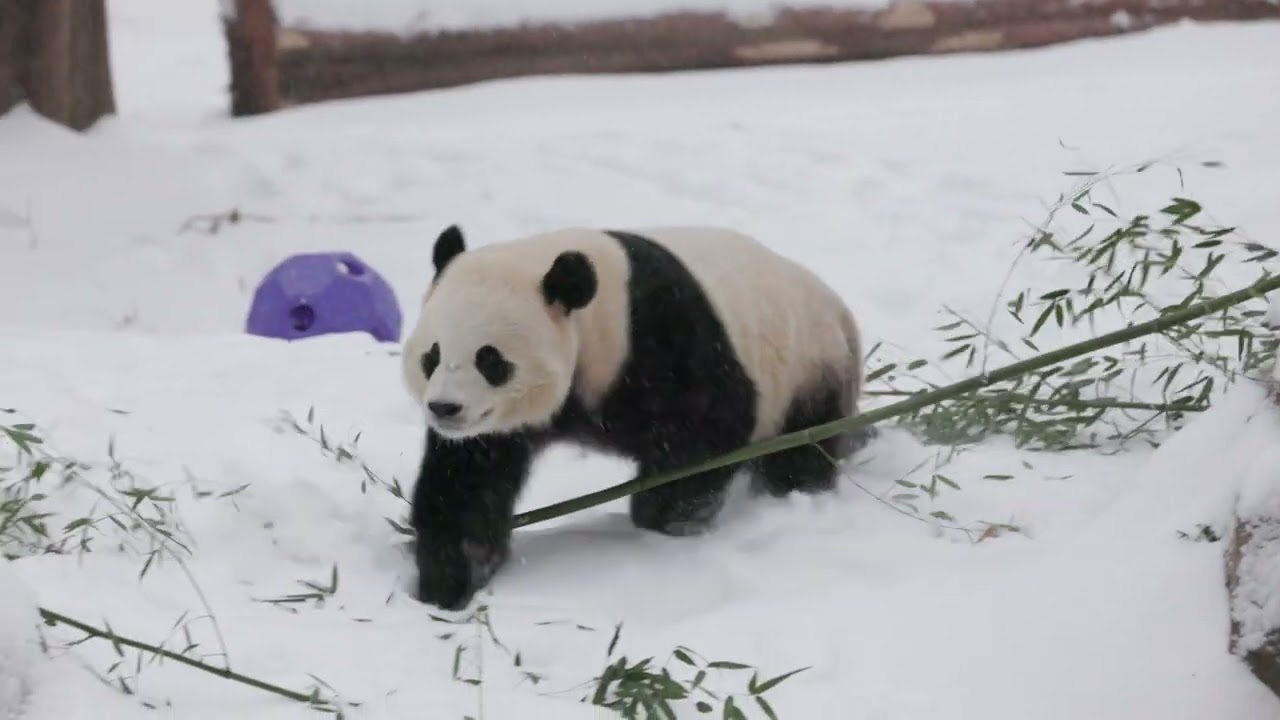- Overview of the behavior and ecological significance of giant pandas, focusing on Bao Li and Qing Bao’s playful antics in the snow.
- Insights into the role of environmental enrichment in captive wildlife care, illustrated by panda snow play.
- The impact of human interaction and modern zoological practices on panda conservation.
- The significance of video documentation in wildlife behavior studies and public engagement.
- A look at the conservation efforts for giant pandas, highlighting their current status and future challenges.
Giant pandas have long captivated human interest with their striking black-and-white coats and gentle demeanor. The video of Bao Li and Qing Bao playing in the snow demonstrates the rare glimpse of their playful nature, putting a spotlight on their behavior and ecological significance. These pandas, currently guests of a renowned zoological facility, offer insights into the role of environmental enrichment in animal welfare. This article explores these themes while considering the broader implications for panda conservation in captivity and the wild.
The intriguing antics of Bao Li and Qing Bao in the snow serve as an important behavioral observation. Giant pandas, native to China’s mountainous regions, are accustomed to snowy environments. In their native habitat, pandas engage in playful behaviors that are critical to their physical well-being. These actions strengthen their muscles and mental acuity, which contribute to their survival tactics in the wild. Observing such behaviors in captivity highlights the critical role that a well-designed environment plays in maintaining these natural instincts.
Environmental enrichment is a cornerstone of modern zoo management, enhancing the lives of animals under human care. For giant pandas, this involves the simulation of their natural habitats. Snow play is a form of enrichment, providing mental stimulation and physical exercise. Such interactions are essential for animals like Bao Li and Qing Bao, enabling them to express their instinctual behaviors and maintain a high quality of life. Zoos aim to recreate experiences that challengingly mimic the complexities of the wild, thus promoting natural behavior patterns.
Today’s zoos have evolved into vital research and conservation centers. Human interaction, when carefully managed, can positively impact panda conservation. Zoological institutions employ advanced technology to monitor health, nutrition, and behavior. These practices are critical, enabling caretakers to tailor unique care protocols for each animal. Bao Li and Qing Bao’s playful antics in the snow illustrate the success of these modern practices in keeping captive animals mentally and physically stimulated.
Video documentation has become a powerful tool in wildlife studies, impacting both research and public engagement. The footage of Bao Li and Qing Bao in the snow offers valuable data for behavioral studies. By studying such interactions, researchers gain insights into the social dynamics and individual preferences of pandas. Furthermore, videos serve as educational content for the public, raising awareness about panda behaviors and the importance of conservation efforts.
While the captivating scenes of Bao Li and Qing Bao playing in snow provide a moment of joy, they also remind us of the ongoing challenges in panda conservation. Giant pandas are a conservation success story, but they remain vulnerable. Habitat destruction and climate change continue to pose threats in the wild. Conservation efforts require international collaboration, sustainable practices, and significant resources to address these threats effectively.
Dedicated conservation programs have helped increase panda numbers in the wild. Successful breeding programs in captivity also contribute to sustaining the population. However, these efforts need ongoing support and adaptation to changing ecological conditions. Modifying conservation strategies in response to human expansion and environmental shifts is crucial for the long-term survival of giant pandas.
Bao Li and Qing Bao have become ambassadors of their species, highlighting the success of zoological care and the necessity of continued conservation. Their playful engagement in the snow not only entertains but educates, symbolizing the bond between humans and wildlife, and the shared responsibility in cultivating an environment where both can thrive.
In the ever-evolving field of zoology and conservation, Bao Li and Qing Bao remain important symbols. They underscore the intricacies of balancing animal welfare with conservation goals. By taking into account the lessons learned from their play, we advance toward a future where giant pandas, and countless other species, flourish both in captivity and the wild.
*****
Source Description
Tumbling in a winter wonderland! This morning, about 5 inches of snow blanketed the Washington, D.C., area, including giant panda Bao Li and Qing Bao’s outdoor habitats. Flakes stuck to their fur as the bears frolicked and somersaulted in the snow. It was paws-itively the panda *snowment* of our dreams!
. . .
Giant pandas Bao Li and Qing Bao explore their snow-covered outdoor habitats Jan. 6, 2025, at the Smithsonian’s National Zoo and Conservation Biology Institute. The bear pair will make their public debut on Friday, Jan. 24. Follow #DCPandas for updates. LEARN MORE: nationalzoo.si.edu/dcpandas.
. . .
TIME STAMPS
0:01-0:37 | Qing Bao
0:38-1:05 | Bao Li
1:06-1:23 | Qing Bao
. . .
MEDIA USE
Media (news) outlets may use the Smithsonian’s National Zoo and Conservation Biology Institute’s giant panda photos/videos for news purposes only with credit to Smithsonian’s National Zoo. Approved purposes include: print/online articles, broadcast reports and social media feeds.


